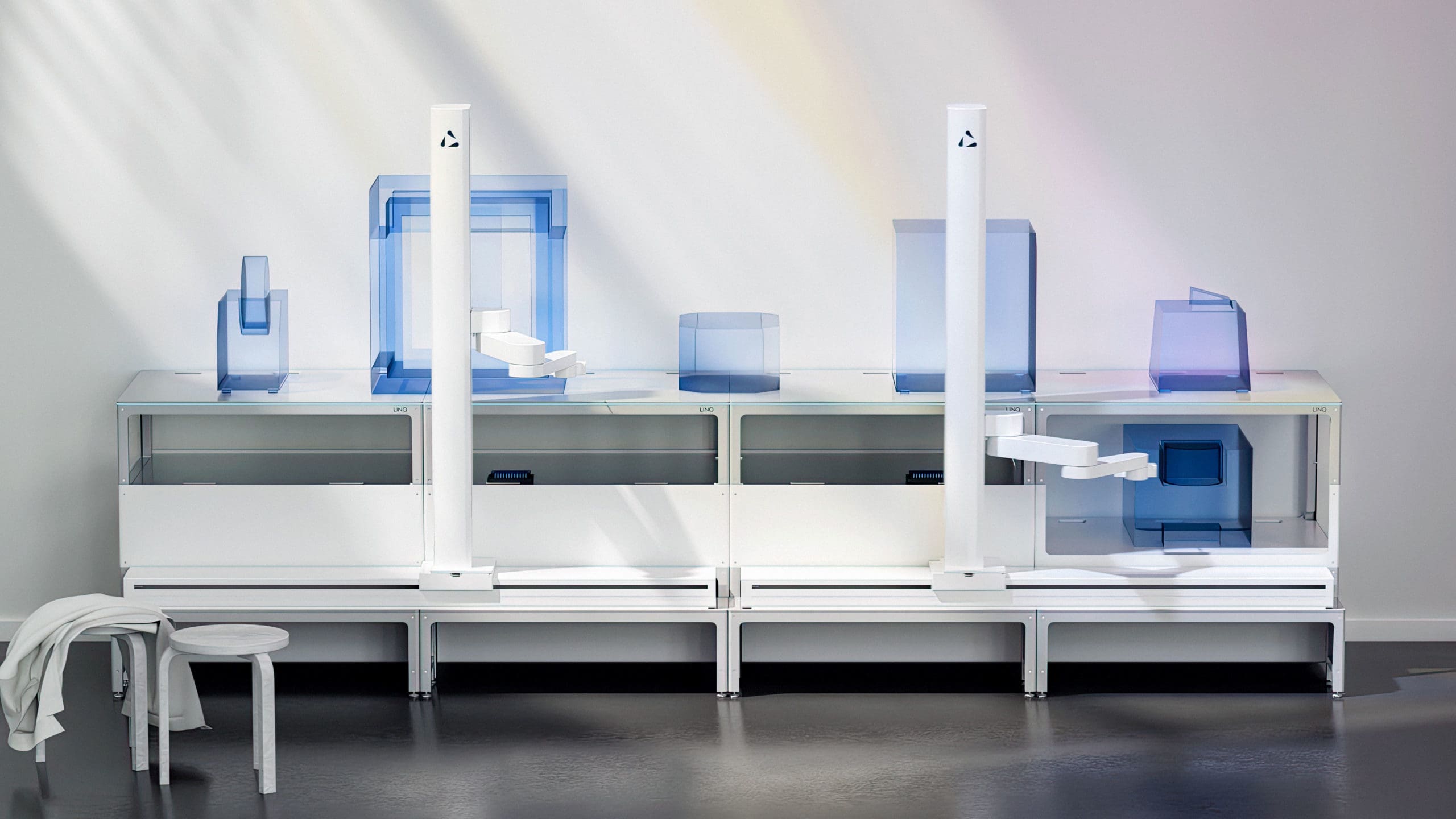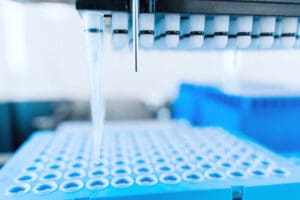In this guide, you`ll find out:
What is a LIMS?
LIMS or Lab Information Management System is software and hardware designed as a solution to managing large numbers of samples and the data that is associated with it, leading to a more streamlined, efficient workflow.
What are the main functions of a LIMS?
The main function of LIMS has traditionally been sample management, however, developments in software capabilities have meant that LIMS can be involved in many aspects of laboratory management. Now it is possible for LIMS software to be utilised in streamlining workflows as well as in generating reports, keeping track of maintenance records, and inventory management.
Types of LIMS
Server-based LIMS
On-premise – or server-based LIMS – requires a laboratory to house and maintain all of the server equipment and software needed for setting up the LIMS system. Although thought to be the most expensive method of implementing LIMS, it offers a centralised place for all of the data to be stored and complete control over data access and security.
Cloud-based LIMS and Software as a Service (SaaS)
Cloud-based LIMS has become the method of choice for many companies. Cloud-based LIMS allows a laboratory to run its whole infrastructure and software through web applications, removing the need for large servers and skilled IT workers to maintain and run them.
SaaS LIMS allows labs to download and install applications through the cloud, as well as providing backups and automatic upgrades. It's usually paid for with a subscription model. The ability to scale with the growth of a laboratory is dramatically improved with cloud-based LIMS as you can add or remove services as needed (1).
The main component for consideration with cloud-based or SaaS LIMS is determining how secure your data needs to be, and whether the model chosen is able to meet the security needs. Furthermore, usage of this LIMS depends on a secure internet connection and the ability to maintain a subscription, which could end up being more costly in the long run.
Hybrid LIMS
Certain LIMS services combine server-based and cloud-based methods to create a hybrid LIMS, in which the laboratory is 100% in control of all its data with the added security of having an on-location backup. The main downside of this is the expense, as the organisation will have to shoulder the costs of maintaining servers alongside the subscription costs of cloud-based services.
What are the components of a LIMS?
A LIMS typically can be optimised to have three main components (2):
1. Enabling sample tracking
LIMS systems are able to integrate barcoding and tracking procedures, allowing for a sample’s journey to be traced from receiving it to the generation of results.
Furthermore, LIMS can be utilised to track aliquots and repeat sample collections, and to create audit records when samples are removed or added to storage.
2. Standardising workflows (protocols and procedures)
By standardising and digitising protocols and procedures, all laboratory staff are able to complete processes in the same way, reducing any variability that may arise with non-standardised protocols.
This also allows for quick updating of protocols, and grants visibility of updates to necessary personnel.
Furthermore, experimental results can be recorded, with outliers highlighted and then sent as reports to the relevant groups.
3. Implementing storage organisation
Keeping track of the location of a sample throughout its storage within a lab is critical for both maintaining chain of custody (CoC), and for increasing the efficiency of laboratory staff. A LIMS system optimised to maintain storage will have information recorded on the specific location of a sample, as well as the more general locations such as the drawer, freezer, and room numbers. This allows for fast retrieval of samples and reduces the potential for errors such as losing samples or using the wrong one.
Advantages of a LIMS
Five benefits of LIMS setups are:
1. Data is centralised
Data centralisation is particularly important when collaborating with large groups, other laboratories, or even just multiple staff within a lab. They allow staff to see data reports as they are generated, and to group them under specific project headings so that no data is lost or misplaced. Furthermore, staff can have access to digitalised protocols, and see sample tracking data, as well as instrument tracking data and audits (3).
LIMS can also be connected to electronic notebooks (ELN) allowing for quick sharing of images, lab notes and sudden changes that may have had to have been undertaken during an experiment.
2. Increased lab efficiency
With a LIMS system covering the often long-winded and banal aspects of laboratory management, staff are able to focus on other processes within the lab, thereby increasing productivity and efficiency.
Additionally, having the capability to store and process large volumes of data allows for high-throughput experiments to be completed, further increasing efficiency and growth within the lab (4).
Discover more ways to super-charge your labs' productivity on our blog.
3. Better quality control and regulatory compliance
With protocols and standard operating procedures (SOPs) being digitalised on one system, specific processes are enforced in the specific way that you need them to be. So, even if multiple people are running the same experiment, it should be run in the same way, decreasing the potential for experimental variability. This, alongside automatic auditing from LIMS software, allows for better identification of quality issues within samples or the instruments used.
Read more about the benefits of automated lab information gathering.
4. Sustainability
Sustainability within the lab has become a hot topic over the years as areas of lab work such as cell culture require the usage of large amounts of one-use plastics. LIMS allows for the digitalisation of many aspects that may usually be written or printed, such as storage locations, data readouts and subsequent analyses, or protocols and SOPs.
5. Reduced human error
Eliminating human error is one of the most sought-after outcomes within a lab, which is why developments in technology have been made to reduce the need for manual handling of samples and to automate long processes that may lead to errors. With LIMS, the potential for storage errors and using the wrong samples is also reduced, as it provides labs with barcoding and tracking information.
Having protocols enforced within a LIMS system means that all staff have to conduct experiments in the same way, reducing the potential for error and increasing reproducibility and accuracy.
LIMS vs ELN
There are key differences between LIMS and Electronic Laboratory Notebook (LEN) software that cater to different laboratory needs.
LIMS can be used to replace spreadsheets and other data management software that requires manual input, whereas ELN can be used to replace paper notebooks.
Each software can be used to record:
LIMS and ELN are able to be used together and even in some cases integrated into one system to enable a more seamless experience of laboratory processes like with the Agilent Smart LIMS (SLIMS) product (5).
What industry uses LIMS?
There are many industries that use LIMS. For example, clinical research uses LIMS for sample management and tracking and environmental labs need LIMS for batch data storage and management (for example from GC/MS). Academic research labs can utilise LIMS to centralise, analyse and share protocols and data between labs. Oil and petrochemical industries require LIMS for batch data storage, regulatory compliance and protocol management, food and beverage companies for sample traceability and health and safety compliance and forensics for tracing CoC, protocol management and regulatory compliance (6).
How to choose the right LIMS for your lab
Key questions to consider when choosing the right LIMS for your lab are (7):
- What do you want from a LIMS?
- How do you want to interact with the LIMS software?
- How customisable should your LIMS be?
- What security levels do you require for your data?
- How usable is the LIMS software?
- How scalable do you need your LIMS software to be?
- What is the cost of implementing LIMS into the current lab setup?
How to implement and use a LIMS: step by step
Once an organisation has selected the LIMS that best suits its purpose, determining how to implement and use the software is next. We’ve collated a short step-by-step guide below:
Step 1: Configuring the LIMS specifically to your needs
This requires determining what the biggest bottlenecks in lab productivity are (such as sample management or storage, data collection, or analysis) and then customising the software to work best for you.
Step 2: Transferring data
This can be the most time-consuming part, as all data will need to be transferred to the new system. Security must be maintained during this process.
Step 3: User-acceptance testing
Testing each phase of LIMS that is implemented and the system as a whole is important to make sure that it's working as needed.
Step 4: Training staff
Key staff will be trained by the suppliers of the LIMS system, and then other staff will be trained as needed to ensure that everyone is aware of the procedures and capabilities of the software.
Step 5: Go live!
Once all of these have been completed the system can go completely live and your lab can fully switch from previous systems.
Step 6 (optional): Validate the software
If your lab has strict regulatory requirements, it may be necessary to validate the software. This will document the specific requirements of the system and then test each part to make sure that it reaches the standard needed(8).

What is the future of LIMS?
In 2019 the LIMS market size was valued at $850 million, with a projected compound annual growth rate of 11.6%. By 2030 market value is set to surpass $2.4 billion (9). This indicates that the implementation of LIMS in labs is growing and is predicted to substantially grow over time.
Companies are already implementing LIMS alongside automated laboratory machinery to revolutionise workflows and reduce the potential for human error.
LIMS can work in tandem with automated systems such as in cell culture or genomics to organise cell lines, keep track of passages, and to monitor the maintenance of cell lines, as well as store data related to any assays completed on cells, lysates, or DNA/RNA – for retrieval anywhere by lab staff.
In order for labs to grow and maintain regulatory and quality standards it will become necessary for some sort of LIMS implementation, so it’s not going anywhere anytime soon.
It’s possible that more labs will move towards a cloud-based service specifically, due to its ease of access and reduced associated costs as well as fully encrypted data.
Discover fully automated lab workflows with LINQ

Our automated lab solutions combine an automated lab bench with lab orchestration software to help laboratories to streamline their processes and improve efficiency and quality. This platform, we call LINQ, has three components to achieve this:
Cloud software
The LINQ software has a simple design with an intuitive optimisable user interface that allows for easy use. This enables labs to produce high-quality reproducible data sets and link with other labs to be able to implement processes anywhere in the world.
Robotics hardware
Our LINQ hardware is compact and modular which allows for easy adaptation to the needs of the lab which also facilitates growth and the implementation of high-throughput processes.
Barcode scanners and sensors enable labs to monitor the success of assays, ensuring reproducibility and removing the need for manual handling of samples, freeing lab staff to work on other processes.
Consultation services
We provide consultation services that assist labs in identifying the needs of the laboratory and in designing solutions to cater to those needs.
Our experts also provide field and permanent on-site support to aid in every step of implementation.
These services are all provided in one monthly payment, with no extra costs for troubleshooting or scheduled maintenance.
Learn more about how our lab automation solution combines hardware, software, and a consultation service to help your lab reach its full potential.
References
1. TraxStar Technologies. On-premise VS cloud Vs on-premise in the cloud for LIMS [Internet]. LinkedIn. 2022 [cited 2022 Dec 8]. Available from: https://www.linkedin.com/pulse/on-premise-vs-cloud-lims-traxstar-technologies?trk=organization-update-content_share-article#:~:text=The%20major%20advantage%20of%20using,your%20internal%20systems%20controlling%20both.
2. GenoFAB. LIMS 101 Setting up a Laboratory Information Management System [Internet]. no date [cited 2022 Dec 8]. Available from: https://www.genofab.com/laboratory-information-management-systems
3. Third Wave Analytics. What is a LIMS and What are They Used For? [Internet]. 2022 [cited 2022 Dec 8].
https://thirdwaveanalytics.com/blog/what-does-a-lims-do/
4. Autoscribe Informatics. Advantages of a LIMS [Internet]. no date [cited 2022 Dec 8].
https://www.autoscribeinformatics.com/resources/blog/advantages-of-a-lims#:~:text=A%20Laboratory%20Information%20Management%20System,accurate%20controls%20of%20the%20process.
5. Agilent. Get the best of both worlds: a LIMS software with an ELN [Internet]. no date [cited 2022 Dec 8].
https://explore.agilent.com/AgilentSlims?gclid=Cj0KCQiAkMGcBhCSARIsAIW6d0BUaHk5-vuFUE-1BXHVRlFTd3Cog4mbVrZ0wWbuO6Fgsh0O7yY2h3waAg2hEALw_wcB&gclsrc=aw.ds
6. Labworks. Which Industries Use LIMS? [Internet]. no date [cited 2022 Dec 8].
https://labworks.com/blog/which-industries-use-lims/
7. Interactive Software. Guide to choosing a LIMS. What you need to know when looking for a laboratory information management system [Internet]. no date [cited 2022 Dec 8].
https://www.interactivesoftware.co.uk/choosing-a-lims/
8. Autoscribe Informatics. 10 Steps to Ensure a Successful LIMS Implementation [Internet]. no date [cited 2022 Dec 8].
https://www.autoscribeinformatics.com/resources/blog/10-steps-to-ensure-a-successful-lims-implementation
9. Research Report World. LABORATORY INFORMATION MANAGEMENT SYSTEM (LIMS) MARKET: MARKET SEGMENTS: BY COMPONENT (SOFTWARE AND SERVICES); BY PRODUCT (ON-PREMISE, WEB-HOSTED AND CLOUD-BASED); BY END-USER (LIFE SCIENCES, CROS, PETROCHEMICAL REFINERIES & OIL AND GAS INDUSTRY, CHE [Internet]. 2021 [cited 2022 Dec 8].
https://www.researchreportsworld.com/laboratory-information-management-system-lims-market-18986948
Further LIMS FAQs
In the context of LIMS, workflows are pre-specified protocols that are required to analyse a sample.
LIMS validation is the process of making sure that the system chosen by a lab is fulfilling its job. This includes the process of creating a validation plan, completing risk assessments, and undergoing tests to demonstrate that the LIMS is installed correctly, operates as expected and is performing to the highest level that it can.
The simple answer is no. While both systems are important during audits and should be integrated together, a LIMS is used during day-to-day lab processes whereas a QMS is generally used during business process and assessment of quality.
LIS is generally more patient-centric and is used to manage clinical diagnostic testing within hospitals. LIMS is utilised within many industries and is centred more around batch testing of samples for example in environmental or pharmaceutical labs.
Related resources

Discover more about laboratory information management systems in our LIMS Wikipedia and...
Read more What is a LIMS (Laboratory Information Management System)?
Discover everything you need to know about automated pipetting, from advantages, applications,...
Read more A complete guide to automated pipetting
In this quick guide, Automata outlines a simple ways to integrate robotics...
Read more A (total) beginner’s guide to lab automation